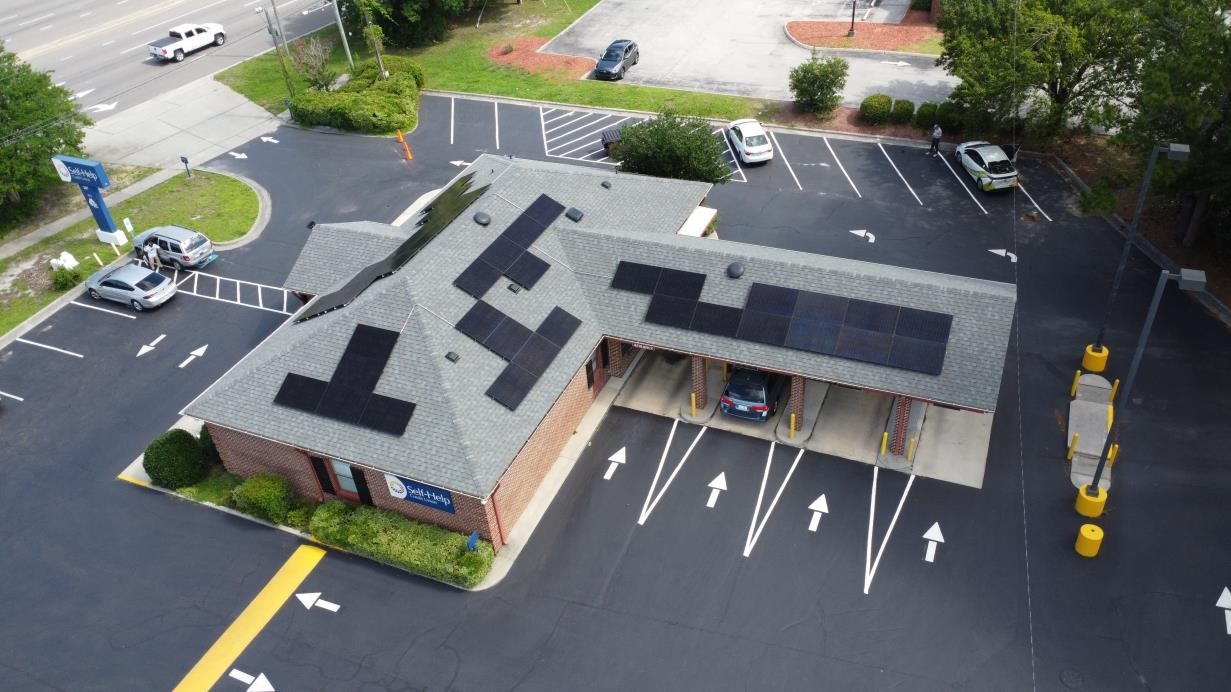
The benefits of solar panels have long been established — they help you save money and they’re a safer, cleaner source of energy for our communities. Self-Help is dedicated to investing in efficient and sustainable energy because it provides long-term benefits to our business and our communities, which is why we have started the process of adding solar panels to our branches.
Four of our branches now run on solar-powered energy, with our latest installment at the Wilmington branch in North Carolina. With this most recent installation, we are using this blog post to share why we have installed solar panels, what the
benefits are, what the process was like, and how you can also take advantage of the solar tax credits expiring soon.
Why install solar panels?
Solar panels are part of Self-Help's larger goal to reduce our carbon footprint. We're carrying out multiple strategies, including adding solar panels to the roofs of our branches. Federal tax credits and recent reductions in the cost of panels
and inverters have helped make it even easier to achieve this goal. Wilmington is our fourth branch to host rooftop solar following Stockton and Modesto in California and Old Fort in North Carolina.
Here are some of the other ways that we’re implementing carbon neutral practices to achieve our goals:
- Investments in efficiency for our extensive real estate portfolio, including:
- Upgrading building lighting to LED
- Installing efficient HVAC systems
- Long-term investments in HVAC systems in our large commercial buildings
- Installing remote HVAC controls that will help us ensure we are not heating and cooling when buildings are unoccupied
Solar panels are one piece of a larger plan to make sure we are utilizing cleaner, more efficient sources of energy that keep our communities safer and healthier.
What are the benefits?
We expect that solar panels will save our members money over the long term! Self-Help is invested in Wilmington and our other solar-powered branches for the long run. We anticipate that rooftop solar will begin making money
for our members in 2039. In the meantime, we have already noticed lower monthly electric bills, and we’re pumping electricity into the grid to benefit our friends and neighbors.
Rooftop solar is also a powerful symbol of Self-Help’s commitment to our environment and the communities we serve. We can already see that it sparks conversations with our members who drop by the branch, providing a great opportunity
to discuss our many great clean energy lending and savings products.
If you’re interested in learning more about our clean energy loans, talk to your local branch staff or head to our webpage on green loans,
including solar, energy saving, and electric vehicle loans.
What was the process like?
At Wilmington, the installation was surprisingly quick and painless. Installation took about a week, and the total process took 2-3 weeks to get all the approvals from the local building permit office and utility officials. We were lucky
that the process ended up being so fast, and it may take longer depending on the area you’re in. It is estimated that the total length of time for solar panel installation typically averages 2.5 - 4 months.
The biggest challenge was navigating the commercial direct-pay tax credits as it was a new process for Self-Help and the IRS. Luckily, if you're interested in using tax credits to install solar for your home, the process for applying
the residential tax credit is more established and well worth any challenges because the tax credit typically covers up to 30% of the total cost of the project, including installation. Despite any challenges Self-Help faced with
our credits, we are grateful to have had the opportunity to take advantage of these savings to help create cleaner communities!
Solar tax credits are expiring soon!
At Self-Help, we have already seen the value of installing solar panels at our branches. If you’re considering going solar too, the federal Residential Clean Energy Tax Credit can help you maximize the (already valuable) savings
that come with having solar panels. However, due to federal budget changes this tax credit will expire on December 31st, 2025.
If you’ve been considering adding solar panels and want to take advantage of the federal tax credit, here are some things to keep in mind:
- You must have your solar panel system installed by 12/31 to qualify.
- Solar panel systems take an average of 2.5-4 months to fully install, so you should start the process as soon as possible for the tax credit to apply.
- The credit equals 30% of the costs, including labor, installation, wiring, etc.
- The credit is nonrefundable, but excess credit not applied to this year’s taxes can be carried forward to reduce taxes in future years.
For an overview of all the energy-saving tax credits expiring soon for purchases like electric vehicles and efficient HVAC systems, check out our recent blog post.
The decision to install solar panels at home is highly personal as you must own your home and there is an upfront cost. Our website contains great information to assist members and potential members considering investments in rooftop solar
and other energy efficiency improvements both at home and on the road. If you’re interested in financing your solar panel installation, learn more about our responsible and affordable solar loans and the rest of our green loans.
At Self-Help, we believe that having access to clean energy sources is a vital component of economic justice as it provides long-term savings and creates healthier and safer environments for communities to thrive.